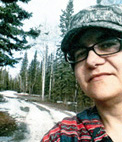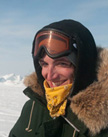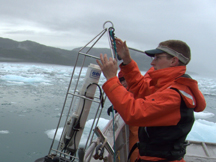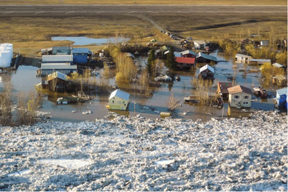CIFAR
Cooperative Institute for Alaska ResearchNews Archive
CIFAR-supported Student Grant Awardee Chris Waigl Featured
May 15, 2015

Courtesy of Chris Waigl.
Christine (Chris) Waigl, one of 8 awardees supported by CIFAR from the 2014 Global Change Student Research Grant competition, is the subject of the current student profile on the UAF Center for Global Change website. Chris, a Ph.D. student in Geophysics, was funded for her project “Boreal forest fire severity and area assessment using mid- and thermal infrared remote sensing and field observations.” We invite you to read Chris’s profile here.
Six Awardees from the 2015 UAF Global Change Student Research Grant Competition to be Funded by CIFAR
May 13, 2015
Thirteen student research projects have been selected for funding through the 2015 UAF Global Change Student Research Grant competition. Of these, six will be supported by CIFAR, a long-time funding partner in this highly competitive grant program which aims to provide students with experience in proposal writing and the peer review system as practiced by natural and social science funding agencies.
The six projects cover a range of topics of interest to NOAA from processes controlling sliding of tidewater glaciers to the effect of economic globalization of the Bristol Bay commercial herring sac roe fishery on the local economy, social structure and identity in the coastal Yup’ik village of Togiak, Alaska.
CIFAR’s ongoing partnership in this competition reflects our programmatic priority on supporting student research on issues relevant to NOAA and the Alaska region.
The new CIFAR-funded students and their projects, along with students and projects funded in prior years, can be found here.
The Alaska Center for Climate Assessment and Policy (ACCAP), the NOAA Regional Integrated Sciences and Assessments (RISA) program at UAF, also became a funding partner for the program this year, and is providing support for two additional student projects.
New Paper on Evolution and Salmon Bioenergetics
March 3, 2015

Photo courtesy of Mike Garvin
We are pleased to report that the “Editor’s Choice” paper in the February 2015 issue of the Journal of Zoological Systematics and Evolutionary Research is a direct result of CIFAR’s support of a UAF Global Change Student Research Grant Competition award. The paper, which focuses on mitochondrial DNA analysis, describes research that followed a surprising find made by first author Michael Garvin as he began work on his CIFAR-funded student grant project.
Changes in mitochondrial DNA over time can be used to describe the genealogies of populations or species (like a family tree) and also as a clock to date different events along the branches of the tree. For instance, this information has been used to determine which groups of humans migrated out of Africa and when. For his CGC project, Mike planned to do this type of analysis with populations of chum salmon to determine when and how they colonized Western Alaska. As a first step he tested to make sure that mitochondrial DNA behaved “neutrally,” i.e., that the changes in the DNA were not part of the evolutionary process.
“To my surprise, the tests I ran determined that one site in particular had undergone ‘positive selection’ and was very likely important for the evolution of different species of Pacific salmon.” Read full story.
CIFAR-funded Student Grant Awardee Kyle Dilliplaine Profiled
February 12, 2015

Photo by Marc Oggier
UAF master's student Kyle Dilliplaine, funded by CIFAR through the 2014 Global Change Student Research Grant competition for his project “Sea ice meiofauna in an ice free Arctic summer; who is present and where will they go?," is the most recent student awardee to be highlighted on the UAF Center for Global Change website. CIFAR is pleased to be a key funding partner in this highly competitive annual program. Read Kyle's profile here.
Bowhead Outreach Film Now Available for Online Viewing
January 23, 2015
The final version of “Arctic Currents: A Year in the Life of a Bowhead Whale” can now be viewed online, with narration in either Inupiaq, St. Lawrence Island Yupik, or English. Follow the links from the UA Museum of the North’s Exhibits & Digital Media - Arctic Currents page.
To learn more about the film, read the articles below:
Bowhead Whale Outreach Film Has Public Debut (October 29, 2014)
Innovative Outreach Film Featuring CIFAR Research Nears Completion (July 10, 2014)
The film will also be available for download in the near future.
Mathis Joins CIFAR Fellows
December 10, 2014

Photo courtesy of Jeremy Mathis.
We are pleased to announce that ocean acidification expert Jeremy Mathis has accepted an invitation to join the CIFAR Fellows. After five years as a faculty member and CIFAR principal investigator at UAF, Mathis joined the NOAA Pacific Marine Environmental Laboratory (PMEL) in June 2012, while maintaining an affiliation with UAF where he coordinates ocean acidification research activities around Alaska. In addition to Mathis, this past year CIFAR has welcomed Denby Lloyd, Executive Director of the North Pacific Research Board, and Katrin Iken, Professor of Marine Biology, UAF, as new Fellows, and Kathy Crane, NOAA Arctic Research Program Manager, and Aimee Devaris, National Weather Service Alaska Division Director, as new members of CIFAR’s Executive Board. We look forward to working with all of them in the coming years.
Bowhead Whale Outreach Film Has Public Debut
October 29, 2014

Hannah Foss. Photo by Susan Sugai.
Thursday, October 23, 2014, marked a milestone for CIFAR as the “beta version” of an exciting new animated outreach film (“Arctic Currents: A Year in the Life of the Bowhead Whale”– see article below from July 2014) based in part on CIFAR PI Steve Okkonen’s collaborative and interdisciplinary research, and produced by the University of Alaska Museum of the North (UAMN), debuted at the annual meeting of the Alaska Federation of Natives.
Film animator Hannah Foss described her feelings on this occasion as “a little nervous and a lot excited. Nervous because I have asked and listened to people whose whole life has been all about these whales, and it makes me nervous acting as a third party to represent these groups and their knowledge.” But on the flip side, “when the same people respond positively or remarked on something being right—it gives me confidence that we’ve tapped into that genuine essence. That the film garners enthusiasm, approval and excitement from professionals who have been around these whales most of their lives—that makes me feel happy and relieved.”
Before the end of 2014 Hannah plans to travel to the communities of Gambell and Savoonga on St. Lawrence Island (SLI), as well as Nome, to show the SLI Yupik-language version and get feedback from audiences there. She will also travel to Barrow to get feedback on the Iñupiat-language version.

Photo by Hannah Foss.
Once the feedback from these audiences has been digested and a few other tweaks made to the film, all three language versions will be available for download from the UAMN website. The film will also be among those shown regularly to Museum visitors. Other uses, including possible incorporation into school curricula, are in the planning stages.
Steve is extremely pleased with the film and notes that the UAMN production team, led by Roger Topp, have done an amazing job weaving traditional knowledge and contemporary science into a compelling story with beautiful visual images.
A trailer for “Arctic Currents: A Year in the Life of the Bowhead Whale” can be viewed at http://youtu.be/UgV_-MYN2W4
Contact: CIFAR PI Steve Okkonen
CIFAR Fellow Heads Major New Arctic Marine Monitoring Effort
October 22, 2014

Katrin Iken. Photo by Raphaelle Descoteaux
CIFAR PI and Fellow Katrin Iken, a professor of marine biology in the School of Fisheries and Ocean Sciences at the University of Alaska Fairbanks, will lead a newly funded $6 million project to establish the Arctic Marine Biodiversity Observing Network (AMBON), a multi-institutional data collection and integration effort focused on the U.S. Chukchi Sea.
AMBON was one of three proposals competitively selected under a NOAA initiative to develop a demonstration project through the National Ocean Partnership Program (NOPP) as a first step toward developing an operational Marine Biodiversity Observation Network (BON) in the U.S. In addition to NOAA, funders include the Bureau of Ocean Energy Management (BOEM) and the Shell Exploration and Production Company.
Besides UAF, AMBON collaborators are from the University of Maryland Center for Environmental Science, the University of Washington Applied Physics Lab, the U.S. Fish and Wildlife Service, NOAA, and the Alaska Ocean Observing System.
The $6 million, 5-year initial phase of AMBON will begin in November 2014 and includes three years of data collection followed by two years of data integration, synthesis and refining of the observing network.
As part of the overall AMBON effort, two PhD students will be supported with funding through CIFAR. The education and training of these students through the AMBON/CIFAR graduate traineeships will be valuable to NOAA’s strategic needs in both climate services and ocean resource management, and follows CIFAR’s priority of graduate student education and outreach.
Read more about AMBON in this UAF press release: http://uafcornerstone.net/uaf-scientist-lead-arctic-marine-biodiversity-observing-network-creation/
Contact: AMBON PI Katrin Iken or CIFAR Director Susan Sugai.
New CIFAR-funded Student Grant Awardee Featured - Kimber DeGrandpre
October 20, 2014

Photo courtesy of Kimber DeGrandpre
Kimber (Tweet) DeGrandpre, a UAF master's student in geophysics whose project “Relative sea level change in western Alaska as constructed from repeat tide gauge and GPS measurements" was selected for support with CIFAR funds through the 2014 UAF Global Change Student Research Grant competition, is currently featured on the UAF Center for Global Change website. CIFAR is a long-standing funding partner in this prestigious annual competition. Read Kimber's profile here.
Innovative Outreach Film Featuring CIFAR Research Nears Completion
July 10, 2014

Steve Okkonen. Photo by Bill Kopplin.
Several years ago, CIFAR PI Steve Okkonen of the UAF School of Fisheries and Ocean Sciences (SFOS) had an inspiration for a unique outreach project.
He wanted to incorporate traditional knowledge, earlier published research, his own ongoing CIFAR-funded research and that of many colleagues from different agencies and institutions (funded by NOAA and the Bureau of Ocean Energy Management/BOEM) to illustrate aspects of bowhead whales’ life history related to their annual migration through the Bering, Chukchi, and Beaufort Seas. The annual nature of the migration itself suggested a calendar as an organizing and presentation format.
This highly successful 2013 calendar, produced and distributed with CIFAR outreach funds, then became the basis for an animated film project funded through the University of Alaska Coastal Marine Institute with support from BOEM, SFOS and the UAF Center for Global Change. The film, “Arctic Currents: A Year in the Life of the Bowhead Whale,” is in the final stages of production by a talented young team at the University of Alaska Museum of the North, who have kept a fascinating blog about the experience.
An engaging scientific storyline relates biological, oceanographic and behavioral aspects of the bowhead whales’ lives that are brought to life through 3-D photorealistic animation. The Museum’s animation team received valuable editorial assistance from and facilitated by the North Slope Borough Department of Wildlife Management. The film will be released with Iñupiat, St. Lawrence Island Yupik, and English narration tracks.
Steve, his research colleagues, the many people who have contributed in large and small ways to the film, along with all of us at CIFAR, are anticipating with great excitement its scheduled premiere this October at the Alaska Federation of Natives annual meeting in Anchorage, Alaska.
For more information, contact CIFAR PI Steve Okkonen.
CIFAR to Support Eight Awardees from the 2014 Global Change Student Research Grant Competition
May 13, 2014
Results from the 2014 UAF Global Change Student Research Grant competition have been released, and CIFAR, a long-standing funding partner in the competition, will be supporting eight of the 14 projects that were selected for funding from a total of 26 submitted. These eight projects address a variety of issues related to CIFAR’s research themes, on topics from sea level change to the impact of climate change on marine organisms and shorebirds. CIFAR’s ongoing partnership in this competition reflects a deeply held commitment to support student research on issues relevant to NOAA and the Alaska region. The 2014 CIFAR-funded students and their projects, along with students and projects funded by CIFAR in prior years, can be found here.
CIFAR-supported Student Grant Awardee Profiled - Lauren Bell
May 13, 2014

Lauren Bell. Photo by Julia Dissen.
CIFAR-supported student Lauren Bell is currently featured on the UAF Center for Global Change website. Lauren, who is pursuing a master’s degree in marine biology at UAF, was awarded funding for her project “Lower trophic level food web structure on the Beaufort Sea slope” through the 2013 UAF Global Change Student Research Grant competition. CIFAR is a long-standing funding partner in this annual competition. You are invited to read Lauren's story here.
CIFAR Leadership Transition
December 9, 2013
After nine years at the helm of the Cooperative Institute for Alaska Research, John Walsh retired this fall. Associate Director Susan Sugai has been appointed as the new director. Congratulations to Susan, and best wishes to John in his retirement!
For more information, contact CIFAR Director Susan Sugai.
New paper: Does calving matter? Evidence for significant submarine melt
November 20, 2013

Tim Bartholomaus. Photo by Nathan Rice.
For many glaciers that flow into the sea, including some in southern Alaska and most of the Greenland and Antarctic ice sheets, the loss of ice to the ocean can dwarf that which is lost to melt beneath the sun’s rays or warm skies. But the exact fate of the ice that reaches the sea is uncertain, and the relative importance of icebergs breaking off the terminus in a process called calving, compared to ice melting in contact with warm ocean water, is unknown at nearly all glaciers. Several recent studies, including some in Alaska, have shown that submarine melt rates can equal, and sometimes exceed, calving rates, but few studies have examined mass loss at glacier termini, and the geographic extent over which rapid submarine melt occurs is not yet clear.
The question of mass loss was addressed by Tim Bartholomaus, a Ph.D. student at the University of Alaska Fairbanks, and colleagues in a recent paper (October 2013) in Earth and Planetary Science Letters. Tim’s work was partially supported by a UAF Global Change Research Grant awarded in 2010 with funding from CIFAR. Read full story.
CIFAR-funded Student Grant Awardee Featured - Greg Deemer
August 27, 2013

Greg Deemer
UAF Atmospheric Sciences graduate student Greg Deemer, whose proposal “Towards improving operational sea-ice forecasts: Serving commercial and societal needs in the North Pacific” was funded by CIFAR through the 2013 Global Change Student Research Grant Competition, is currently the featured student on the Center for Global Change website. See story here.
CIFAR Begins New 5-year Cooperative Agreement
August 16, 2013
As of July 1, 2013, the Cooperative Institute for Alaska Research (CIFAR) is operating under a new 5-year cooperative agreement (NA13OAR4320056), a renewal of the original 5-year agreement (NA08OAR4320751) that established CIFAR in 2008. This renewal is based on the “outstanding” rating CIFAR received during its program review in July 2011. For more information on the new cooperative agreement, contact CIFAR Associate Director Susan Sugai.
CIFAR Research Used by National Weather Service to Better Predict Flooding
August 8, 2013

Flooding in Galena, Alaska, May 2013. National Weather Service photo.
Severe late-spring flooding this year along the Yukon River dramatically underscored the importance of accurately predicting snowmelt and river ice breakup in Alaska, when residents of Galena were evacuated with only a moment’s notice as their community was inundated with water and ice on Memorial Day weekend.
CIFAR researchers Katrina Bennett and Jessica Cherry have been working with the National Weather Service’s Alaska-Pacific River Forecast Center (APRFC) to improve the accuracy of snowmelt processes in the models used by the APRFC. Read full story.
Six Global Change Student Research Grants Funded by CIFAR through 2013 Competition
April 29, 2013
Once again CIFAR is pleased to announce their support of student research proposals selected for funding through the UAF Center for Global Change’s annual student research competition. Twenty-six proposals from a variety of disciplines were submitted to the 2013 competition; the review panel recommended 13 of them for funding. Six projects focused on CIFAR themes will be supported by CIFAR task I education and outreach funds. In addition CIFAR will fund the second year of a two-year project from the 2012 competition. CIFAR’s long-time role as major funding partner in this competition reflects our ongoing commitment to support student research that addresses issues relevant to NOAA and the Alaska region. A list of the 2013 CIFAR-funded students and their projects can be found here.
2012 RUSALCA Field Season Successfully Completed

Lauren Bell and Bodil Bluhm work with samples on the RUSALCA research cruise. Photo by Katrin Iken, University of Alaska Fairbanks.
October 22, 2012
During the first leg of the summer 2012 RUSALCA research cruise, scientists retrieved three moorings that had been left in the Russian waters of the Bering Strait for two years. The multidisciplinary second leg successfully concluded on September 17, 2012, when Russian and American scientists and their extensive sample collections made their way home after two and half weeks in the Bering Strait and Chukchi Sea. In spite of bad weather and sea ice, most research objectives were achieved. Additional information on the 2012 RUSALCA cruise and findings is available on the RUSALCA website and will be included in the next CIFAR annual report.
RUSALCA Research Cruise
(9/7/2012) - The second interdisciplinary research cruise in the current five-year phase of the Russian–American Long-term Census of the Arctic (RUSALCA) project, a joint U.S.–Russia research program in the Bering and Chukchi Seas, is currently underway. Scientists involved in five CIFAR projects focusing on oceanic fluxes, interactions of productivity and nutrient processes, zooplankton communities, arctic food web structure, and fish ecology and oceanography are onboard the Russian research vessel Professor Khromov and will return to Nome on September 17.
- Photos and stories from the cruise can be found on NOAA's Ocean Explorer website.
- Learn more about RUSALCA on CIFAR's RUSALCA page.
Renewal of the Cooperative Institute for Alaska Research (CIFAR) Award to June 30, 2018
(8/7/2012) - >Based upon the “outstanding” review rating that CIFAR received from the NOAA Science Advisory Board review panel, consultation with NOAA programs who have partnered with CIFAR, and NOAA’s future research needs in the Alaska region, Robert S. Detrick, Assistant Administrator for the Office of Oceanic and Atmospheric Research (OAR) has recommended that NOAA provide a full five-year renewal, with no restrictions on funding level for the Cooperative Institute for Alaska Research at the University of Alaska Fairbanks.
The review team summary states: “The quality, scope, and timeliness of CIFAR’s science are exemplary, as seen in presentations, publications, and other products. The CIFAR-supported student research is yielding an astonishingly high return on investment, both because of the quality of the science and the relevance of the science to important practical questions ranging from stock assessment to polar bear conservation to predicting glacial melt.... Especially noteworthy is the high leverage achieved by minimal CIFAR support that helps close funding gaps and recruit students in the area of stock assessment, an area that is recognized as an important national need. In general, CIFAR excels at leverage, collaboration, and avoiding redundancy. The climate change and variability and coastal hazards research is simultaneously world class and directly related to operations.”
CIFAR thanks the members of CIFAR’s executive board and fellows as well as the CIFAR-funded students and faculty who directly contributed to CIFAR’s “outstanding” review in July 2011.
CIFAR Funds Six New Global Change Student Research Grant Awardees
(5/9/2012) - Sixteen student projects from UAF and UAA have been selected for funding through the 2012 UAF Center for Global Change student research competition. CIFAR is a funding partner in this competition and is pleased to provide funding to support 6 of this year’s awardees (5 graduate students and 1 undergraduate). In addition to the new CIFAR awardees, two students will be funded through CIFAR for the second year of their projects that were initially awarded in 2011. These investments are part of CIFAR’s ongoing commitment to support student research that addresses issues relevant to NOAA and the Alaska region. See a list of the 2012 CIFAR-funded students and their projects.
CIFAR Funds Five Global Change Student Research Grant Awardees
(5/5/2011) - All four of the NOAA mission goals require highly trained scientists and managers, and NOAA human resource needs include research scientists with interdisciplinary training in the physical, environmental, and social sciences. In response to these needs, CIFAR has placed specific emphasis upon competitively supporting graduate and undergraduate students (in addition to those supported on CIFAR research projects) whose research addresses issues critical to both NOAA and the Alaska region. As part of this ongoing commitment, we are pleased to announce that CIFAR has invested Task I funds (both federal and University of Alaska match) to support five graduate students among the recently announced 2011 awardees of the Global Change Student Research Grant Competition. See a list of the students and their departments and proposal titles.
James Partain joins CIFAR Executive Board
(11/16/2010) - CIFAR is pleased to announce that James Partain, who was recently appointed NOAA Regional Climate Director for Alaska, is the newest member of the CIFAR Executive Board. Partain served as one of CIFAR's Fellows under the previous cooperative agreement, and we are very happy to welcome him back in this new capacity.
Ocean acidification in the Gulf of Alaska
(11/16/2010) - Jeremy Mathis, a University of Alaska Fairbanks assistant professor and ocean acidification (OA) expert, has received support from NOAA Fisheries (Alaska Fisheries Science Center, Juneau, AK) through CIFAR to deploy the first moored surface and deep water measurements of OA in Alaska’s marine ecosystems. Mathis and co-workers are currently designing the moorings that will be deployed at long-term monitoring sites GAK-1, in the Gulf of Alaska, and M-2, in the southeastern Bering Sea, in March and May 2011, respectively. Data from these moorings will be returned in real-time via satellite, so the atmospheric measurements of CO2, and surface and deep measurements of pH, will become available shortly after deployment.
New and improved Proposals page available
(9/22/2010) - Prospective PIs are invited to visit our newly revamped proposals page, which provides basic information about submitting a proposal to CIFAR as well as some important post-award information.
Postdoctoral Opportunities: Climate Variability and Change and Coastal Hazards
(October 2008) - The International Arctic Research Center (IARC) and CIFAR have two positions available for visiting postdoctoral scientists.
[THIS JOB POSTING IS NOW CLOSED]
CIFAR participates in marine science course for K-12 Teachers

(August 2008) - Scientists from CIFAR, Alaska Sea Grant Marine Advisory Program, and the International Arctic Research Center teamed up to teach a one-credit lecture, lab and field course—Climate Change in Alaska Estuaries—at the Kasitsna Bay Laboratory June 22-27, 2008. Read more about "CIFAR participates in marine science course for K-12 Teachers."
New Cooperative Agreement Awarded
(May 2008) - Following a competitive application process, CIFAR has been awarded a new 5-year cooperative agreement as the NOAA Alaska Regional Cooperative Institute, beginning July 1, 2008.
To better reflect the Alaska regional aspect to the new cooperative institute, the acronym CIFAR will now represent the new "Cooperative Institute for Alaska Research" (rather than "Arctic" as in the past).
Under the new agreement CIFAR will have three broad research themes: (1) Ecosystem Studies and Forecasting; (2) Coastal Hazards; and (3) Climate Change and Variability. Read more about "New Cooperative Agreement Awarded."
CIFAR funds 17 International Polar Year Student Traineeship Awards
(November 2006) - Following a competitive review process, seventeen CIFAR International Polar Year (IPY) projects totaling $330,031 have been funded. These IPY student traineeship awards will fund 10 undergraduate and 13 graduate students working on a wide variety of NOAA polar issues in the physical, biological, and social sciences during the IPY that extends from 2007 to 2008. As part of the IPY legacy, these CIFAR student traineeships support students doing research in areas important to NOAA missions and for capacity building in Alaska.
The list of successful CIFAR IPY student projects is given here.
RUSALCA Funding Status
(November 2006) - A review panel met on June 5, 2006 to evaluate proposals submitted in response to the AO issued by CIFAR for the Russian-American Long-term Census of the Arctic (RUSALCA). After considering the panel's recommendations, NOAA's Office of Arctic Research notified 11 PI teams that their proposals are being held for possible funding in 2007, pending availability of funds.
PIs on three additional proposals have received similar notification following a second, targeted RUSALCA AO focusing on (1) studies of primary productivity and related hydrographic measurements; and (2) modeling proposals for the RUSALCA study area.
CIFAR Director Chairs Regional AAAS Meeting
(June 2006) - CIFAR Director John Walsh is chairing the annual science conference of the Arctic Division of the American Association for the Advancement of Science (AAAS), which will be held 2-4 October 2006 in Fairbanks, Alaska. A wide variety of sessions are being planned around the theme "The State of the Arctic." Abstract submissions are due by 1 August and early registration rates are available through September 18.
CIFAR Announcement of Opportunity and Call for Proposals
(January 2006) - CIFAR initiates Announcement of Opportunity (AO) and Call for Proposals for the joint US-Russia RUSALCA Program in the Bering and Chukchi Seas. Proposals are requested for work to begin in 2007 or 2008 for a period of up to five years.
CIFAR Coordinates Workshop on NOAA Arctic Research Priorities
(April 2005) - A Workshop on Arctic Priorities, convened by Chet Koblinsky and John Calder of NOAA on 2-3 February 2005 in Silver Spring, was coordinated by CIFAR. The workshop served to focus input to NOAA's planning process for FY2008-2012, particularly for the International Polar Year and the upcoming SEARCH (Study of Environmental Arctic Change).
Read more about "CIFAR Coordinates Workshop on NOAA Arctic Research Priorities."
New Associate Director Joins CIFAR
(November 2004) - The Cooperative Institute for Arctic Research (CIFAR) welcomes Dr. Susan Sugai as its new Associate Director [full story].
New CIFAR director appointed
(August 2004) - University of Alaska President Mark Hamilton recently appointed Dr. John E. Walsh as Director of CIFAR [full story], effective September 1, 2004.


